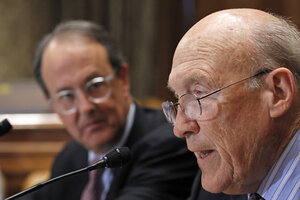Bowles-Simpson plan raises everybody's taxes
Bowles and Simpson want to raise taxes across the board while lowering rates. How? Ending deductions and credits.

Erskine Bowles, left, accompanied by former Wyoming Sen. Alan Simpson, co-chairmen of President Obama's bipartisan deficit commission, take part in a news conference on Capitol Hill in Washington, Nov. 10. Their plan would raise taxes, but remains progressive.
Alex Brandon / AP
Critics of the deficit reduction plan offered by the co-chairs of President Obama’s fiscal commission have blasted it for being both a tax hike (bad if you’re a conservative) or a tax cut for the wealthy (bad if you’re a liberal). So which is it?
The Tax Policy Center has taken a preliminary look at one version of the tax plan offered by Erskine Bowles and Alan Simpson. And Paul Krugman & friends can rest easy. The Bowles-Simpson proposal is indeed an across-the-board tax increase-- and a fairly progressive one at that. In 2015, the lowest earners would face an average cut in their after-tax income of 3.4 percent or about $400. Middle-income households (those earning an average of about $60,000) would see their after-tax incomes fall by 4 percent or about $1,900. On the other end of the economic food chain, the top one percent of earners (who earn an average of about $2 million) would lose about $77,000 (5.3 percent) while the top 0.1 percent would see their after-tax incomes cut by nearly 8 percent, or close to $500,000.
The TPC estimate comes with a number of caveats. It assumes essentially the law we had in 2009. The 2001 and 2003 tax cuts still apply in 2015, about 25 million middle-income households continue to be protected from the Alternative Minimum Tax, and the 2009 estate tax is back on the books. Given political realities these days, that guess is a good as any, but it is a guess. And if the Bush-era tax cuts actually do expire, the distributional impact of the Bowles-Simpson plan would be quite different: While low-income households and the top one percent of earners would be hit with a tax increase, the upper middle class would enjoy a small tax cut averaging about 1 percent.
The TPC estimate is also static, thus it assumes no behavioral response to the proposed tax law changes. However, thanks to lower marginal rates and the smaller deficit in the overall plan, the economy could grow faster than the co-chairs predict and generate more tax revenue.
In addition, keep in mind that Bowles and Simpson did not propose a single tax reform plan. Rather, they offered a number of possible versions. The most radical is getting the most attention, but it is less a plan than a concept. The idea: eliminate or scale back the nearly $1 trillion in targeted tax breaks--such as the mortgage interest deduction, the exclusion for employer-sponsored health insurance, and credits for hybrid cars--that currently litter the Revenue Code. Simpson and Bowles would use some of the cash to lower rates and the rest to reduce the deficit by about $750 billion over a decade.
While Bowles and Simpson start with the goal of ending all tax expenditures, neither has just fallen off the proverbial cabbage truck. They recognize that completely wiping out such favorites as the mortgage interest deduction is about as likely as the Dallas Cowboys winning this year’s Super Bowl. Thus, they also propose scaled back versions that would trim but not eliminate popular tax breaks.
Because modeling a concept is not so easy, TPC picked the version of their plan that would eliminate all deductions, credits, and exclusions except for the earned income credit and the child credit (two big safety net programs for working families). In this option, Bowles and Simpson would drive individual tax rates down to 9, 15, and 24 percent and repeal the AMT. Importantly for the fate of high-earners, however, their plan would also tax capital gains and dividends as ordinary income and end the loophole that allows gains to go tax free if they are held until death.
It is important to remember that the co-chairs have not introduced a bill. Rather, they have created a 50-page powerpoint with the aim of delivering a simple message: If we are serious about balancing the budget and managing our debt, we are all going to have to sacrifice. We all must live with fewer government services and benefits than we anticipated, and higher taxes. The details can be sorted out later.
Thus, Bowles and Simpson have a clear goal: They want to raise taxes across the board while lowering rates. And TPC’s preliminary projections suggest that’s pretty much what they’d do.
Btw, as TPC learns more details about their other reform variations--such as trimming, but not eliminating, other deductions and credits--we’ll model them as well.
Add/view comments on this post.
------------------------------
The Christian Science Monitor has assembled a diverse group of the best economy-related bloggers out there. Our guest bloggers are not employed or directed by the Monitor and the views expressed are the bloggers' own, as is responsibility for the content of their blogs. To contact us about a blogger, click here. To add or view a comment on a guest blog, please go to the blogger's own site by clicking on the link above.
